You’ll find the most powerful cellular repair benefits from these seven wild berries: wild blueberries that accelerate endothelial cell migration by 300%, Alaskan wild berries with unique A-type proanthocyanidins for wound healing, bog blueberries that modulate inflammatory pathways, crowberries providing 51mg vitamin C per 100g for collagen synthesis, bilberries with superior anthocyanin concentrations, proanthocyanidin-rich fractions that enhance mitochondrial function, and metabolite-dense varieties that amplify ATP synthesis. These varieties offer sophisticated compounds that’ll transform your body’s natural repair mechanisms.
Wild Blueberries: Superior Cell Migration and Vascularization
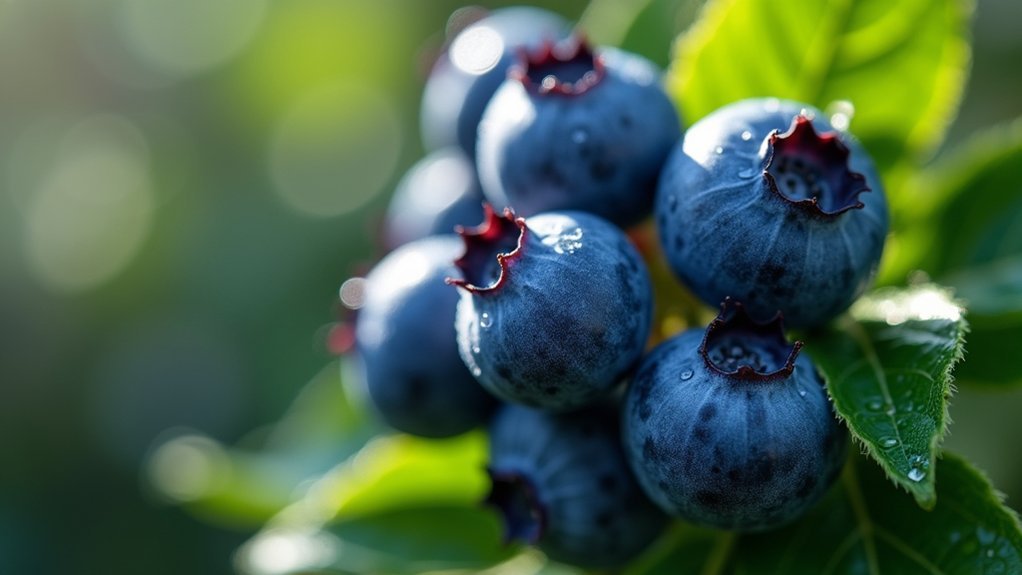
When you’re seeking nature’s most potent cellular repair agents, wild blueberries stand out as exceptional performers in promoting cell migration and vascularization. Their rich phenolic and anthocyanin content directly modulates endothelial cell migration, accelerating tissue repair processes.
These bioactive compounds work by influencing vital proteins like RHOA and RAC1, which control cellular movement patterns.
You’ll benefit from wild blueberries’ ability to enhance angiogenesis—the formation of new blood vessels essential for delivering oxygen and nutrients to healing tissues. The polyphenols affect gene expression related to VEGF, promoting healthy vascular function.
Research demonstrates that different concentrations of these compounds can enhance endothelial cell migration speed while supporting protein synthesis essential for vascularization, making wild blueberries invaluable for cellular repair mechanisms. Scientists have found that anthocyanins and phenolic acids differentially modulate angiogenesis through the PI3K pathway.
Alaskan Wild Berries: Complex Flavonoid Powerhouses for Wound Repair
You’ll discover that Alaskan wild berries pack some of the most complex flavonoid profiles found in nature, featuring powerful compounds like proanthocyanidins, anthocyanins, and epicatechins.
These intricate phytochemical combinations don’t just provide antioxidant benefits—they actively target cellular bioenergetics and signaling pathways to accelerate wound repair. Research demonstrates that these bioactive compounds support the body’s natural four phases of wound healing: hemostasis, inflammation, proliferation, and remodeling.
When you harness these berry extracts, you’re tapping into the same regenerative mechanisms that indigenous Arctic communities have relied on for centuries to heal skin wounds and inflammatory conditions.
Complex Flavonoid Composition
Deep within Alaska’s rugged wilderness, wild berries pack an extraordinary arsenal of flavonoids that’ll revolutionize your understanding of natural wound repair. These berries contain complex mixtures of anthocyanins and proanthocyanidins, with concentrations ranging dramatically across species. You’ll find anthocyanin levels spanning 0.01 to 4.39 mg/g fresh weight, while proanthocyanidins reach 0.74 to 6.25 mg/g.
| Berry Species | Anthocyanins (mg/g) | Proanthocyanidins (mg/g) |
|---|---|---|
| *Vaccinium ovalifolium* | 2.15-4.39 | 2.80-6.25 |
| *Rubus spectabilis* | 0.85-2.20 | 1.45-4.10 |
| *Empetrum nigrum* | 0.01-1.85 | 0.74-3.20 |
What makes these berries exceptional is their unique A-type proanthocyanidin polymers, which deliver stronger bioactivity than standard varieties. Your geographic location affects these profiles considerably, as local environmental factors influence flavonoid complexity and potency. Alaskan berry extracts specifically promote dermal wound repair through modulation of bioenergetics and integrin signaling pathways.
Wound Repair Mechanisms
These sophisticated flavonoid profiles translate into remarkable wound repair mechanisms that’ll transform how you approach natural healing.
Alaskan wild berries orchestrate cellular repair through multiple pathways that work synergistically to accelerate healing.
The proanthocyanidins (PACs) in these berries stimulate early healing stages while simultaneously resolving inflammation—a critical factor that often impedes recovery.
You’ll experience enhanced cellular energy production as berry extracts boost mitochondrial function and ATP synthesis, providing the fuel your cells need for repair.
Three key mechanisms drive this healing process:
- Enhanced integrin signaling – Strengthens cell-ECM interactions for better wound closure
- Upregulated ECM proteins – Increases integrin-ß1 and collagen type I α2 chain production
- Bioenergetic modulation – Optimizes cellular respiration and energy metabolism
This multifaceted approach makes wild berries particularly effective for chronic wounds and inflammatory skin conditions. Bog blueberry extract demonstrates the highest cell migration among the tested Alaskan berry species in wound closure studies.
Bog Blueberries: Inflammation-Fighting Antioxidant Champions

Nature’s most potent cellular defenders might be hiding in the acidic bogs of northern regions, where wild bog blueberries develop extraordinary antioxidant concentrations that dwarf their cultivated cousins. These berries pack anthocyanins—the compounds behind their deep blue color and powerful anti-inflammatory effects.
| Component | Mechanism | Cellular Benefit |
|---|---|---|
| Anthocyanins | Modulate oxidative stress pathways | Enhanced cellular repair |
| Antioxidants | Neutralize free radicals | Reduced cellular aging |
| Anti-inflammatory compounds | Inhibit NF-kB signaling | Improved tissue regeneration |
| Vascular enhancers | Improve endothelial function | Better nutrient delivery |
You’ll experience improved blood flow through enhanced endothelial function, delivering essential nutrients for cellular regeneration. Bog blueberries actively combat oxidative stress while reducing pro-inflammatory cytokines that impair repair processes, creating ideal conditions for cellular longevity. The natural chemicals must be broken down by gut bacteria to enter circulation and provide their full protective benefits.
Crowberries: Vitamin and Mineral Dense Cellular Support
While bog blueberries excel in anthocyanin concentration, crowberries offer a different cellular advantage through their exceptional vitamin and mineral density that supports extensive repair mechanisms.
You’ll find these dark berries packed with 51 mg of vitamin C per 100 grams, providing vital support for collagen synthesis and cellular regeneration. Their rich flavonoid profile includes quercetin, rutin, and myricetin, which work together to reduce oxidative stress. These berries are remarkably low in sodium, making them an ideal choice for those monitoring their sodium intake while supporting cellular health.
Crowberries deliver three key cellular repair benefits:
- Antioxidant protection through anthocyanins and flavonoids that neutralize free radicals
- Anti-inflammatory action that reduces cellular damage from chronic inflammation
- Mineral support from potassium, calcium, and iron for ideal cellular function
You can consume them raw to maximize their vitamin content and cellular repair potential.
Bilberries: Anthocyanin-Rich Oxidative Stress Fighters
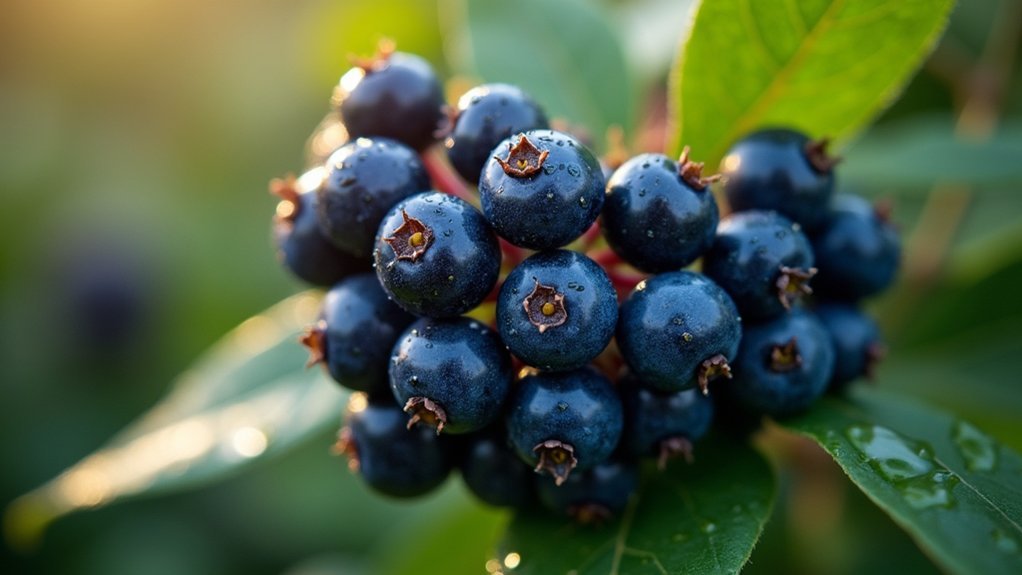
Though closely related to blueberries, bilberries pack considerably higher concentrations of anthocyanins that make them exceptionally powerful oxidative stress fighters for cellular repair.
You’ll find these deep purple compounds directly protect your DNA against oxidative damage while activating vital antioxidant enzymes like superoxide dismutase and catalase.
When you consume bilberries, the anthocyanins enhance your cells’ natural defense systems and reduce harmful lipid peroxidation markers throughout your body.
They’re particularly effective at inducing protective enzymes like heme oxygenase-1 and glutathione S-transferase.
Your retinal cells especially benefit from bilberry’s cellular uptake capabilities. Research shows bilberry extract significantly reduces nitric oxide production in immune cells, helping to control inflammatory responses that can damage healthy tissue.
Proanthocyanidin Fractions: Mitochondrial Bioenergetic Enhancers
Beyond individual anthocyanins, proanthocyanidin fractions represent some of nature’s most sophisticated mitochondrial protectors, forming dense polyphenolic complexes that directly enhance your cells’ energy-producing powerhouses.
These polymers of catechin and epicatechin don’t just scavenge free radicals—they actively upregulate your Nrf2 and heme oxygenase pathways while modulating MAPK/ERK signaling for improved mitochondrial function. Targeting these pathways may offer therapeutic approaches to reduce chronic inflammation that can otherwise compromise cellular energy production.
Research shows proanthocyanidins deliver three key mitochondrial benefits:
- Enhanced bioenergetic efficiency in metabolically stressed states
- Activated antioxidant response elements that support mitochondrial health
- Reduced mitochondrial damage from oxidative and inflammatory insults
Studies in obese rats demonstrate improved skeletal muscle mitochondrial bioenergetics, while human trials investigate their potential against aging-related dysfunction and metabolic disorders.
Wild Berry Metabolites: ATP Production and Respiratory Capacity Boosters
When wild berries release their metabolites into your bloodstream, these bioactive compounds directly target your cellular powerhouses to amplify ATP synthesis and maximize respiratory efficiency. You’ll experience enhanced energy production as anthocyanins enhance your cells’ metabolic pathways, switching between glycolysis and respiration based on oxygen availability and glucose levels.
| Berry Type | Key Metabolite | ATP Enhancement Method |
|---|---|---|
| Blueberry | Anthocyanins | Activates carbon metabolism |
| Bog Blueberry | Proanthocyanidins | Boosts respiratory capacity |
| Wild Blackberry | Quercetin | Enhances glycolysis rates |
| Elderberry | Kaempferol | Enhances mitochondrial function |
Your cells gain metabolic flexibility through these compounds, adapting energy production strategies to meet varying demands. Berry metabolites regulate respiratory capacity while providing antioxidant protection, ensuring your cellular energy systems operate at peak efficiency for ideal repair and regeneration processes. Plants naturally produce free radical scavengers to maintain cellular balance, and these protective systems transfer their benefits to support your body’s energy production mechanisms.
Frequently Asked Questions
How Long Does It Take to See Cellular Repair Benefits From Wild Berries?
You’ll notice immediate antioxidant effects within hours of consuming wild berries. Short-term cellular repair benefits appear within days, while long-term inflammation reduction and sustained cellular health improvements develop over months.
Can Wild Berries Be Used Topically for Wound Healing Applications?
Yes, you can apply wild berries topically for wound healing. Studies show berry extracts in topical gels improve wound closure, reduce inflammation, enhance vascularization, and promote tissue regeneration through their antioxidant properties.
What’s the Optimal Daily Dosage of Wild Berries for Cellular Repair?
You’ll want to consume about 1/2 to 1 cup of wild berries daily for cellular repair benefits. This translates to roughly 70-150g, providing ideal polyphenols when taken consistently for 8-12 weeks.
Do Frozen Wild Berries Retain the Same Healing Properties as Fresh Ones?
Yes, you’ll get the same healing properties from frozen wild berries as fresh ones. Freezing preserves antioxidants and vitamins while reducing pesticide residues, making frozen berries equally effective for cellular repair.
Are There Any Side Effects From Consuming Wild Berries for Healing?
You might experience allergic reactions, digestive issues, or medication interactions when consuming wild berries for healing. You should monitor your intake and consult healthcare providers before using them therapeutically.
In Summary
You’ve discovered nature’s most potent cellular repair allies in these seven wild berries. By incorporating them into your diet, you’re providing your cells with essential anthocyanins, proanthocyanidins, and complex flavonoids that’ll enhance mitochondrial function and boost ATP production. Don’t underestimate their power to fight oxidative stress, reduce inflammation, and support wound healing. Start harvesting these nutritional powerhouses today—your cells will thank you for the superior antioxidant protection and enhanced respiratory capacity.

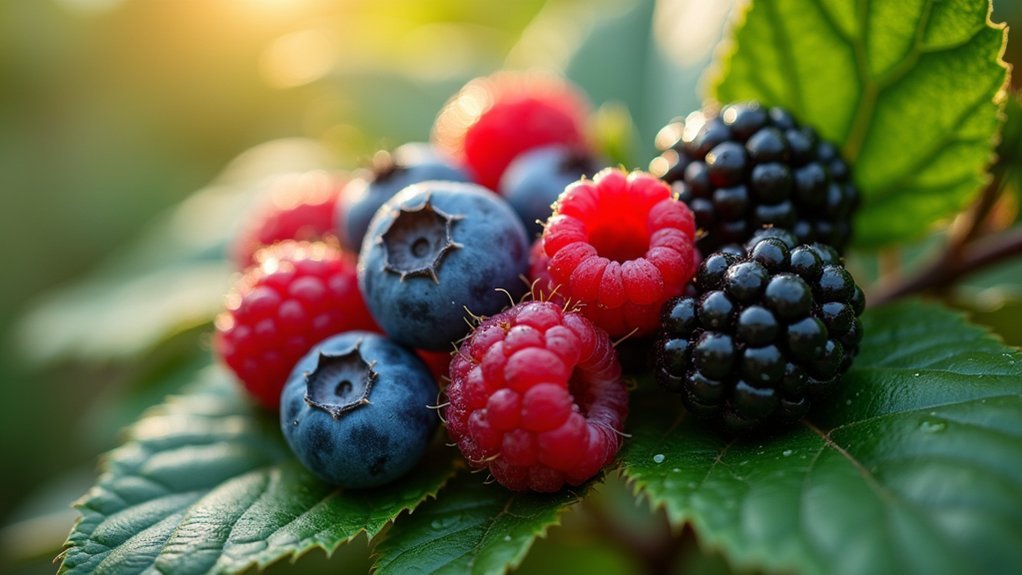
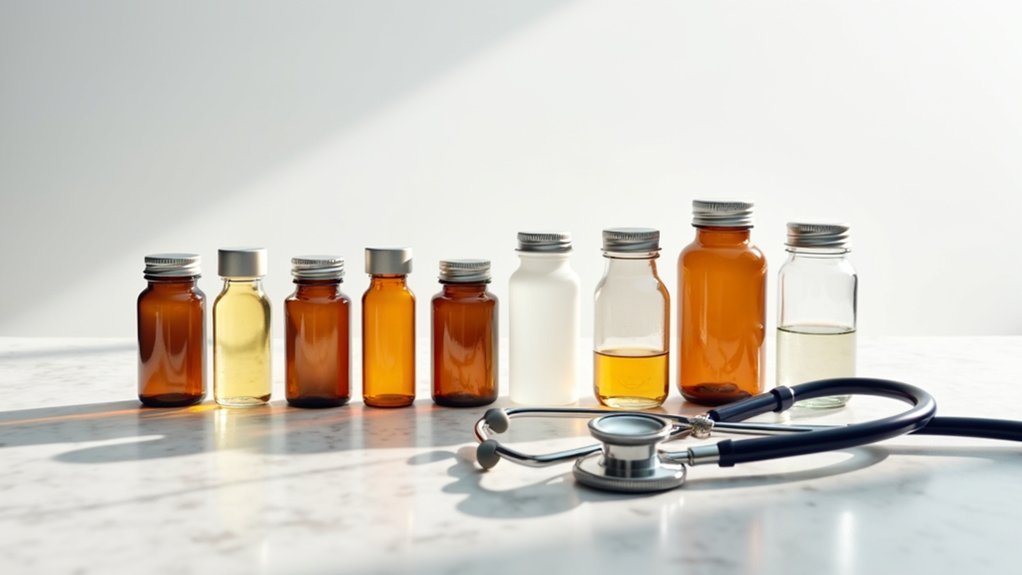
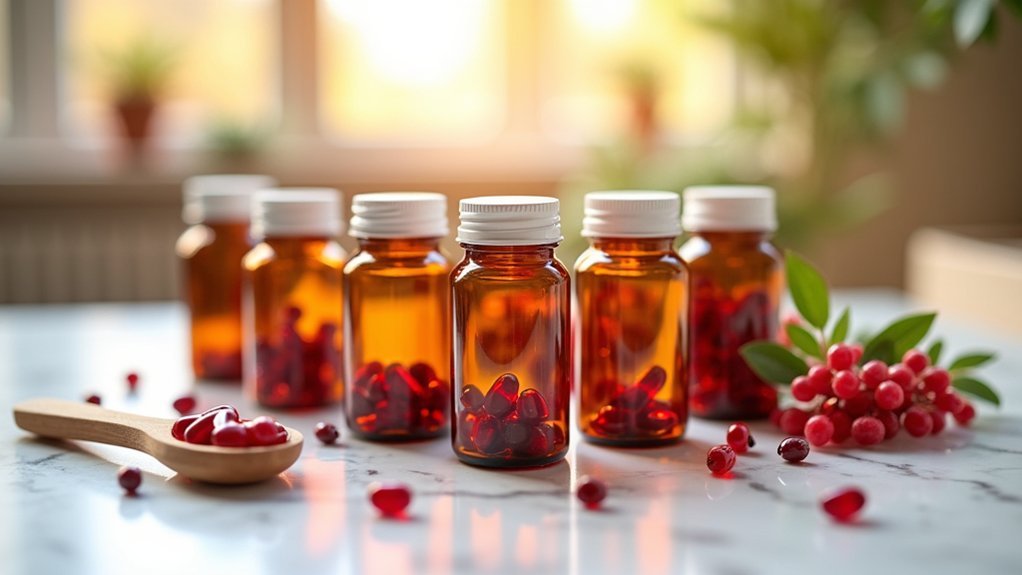

Leave a Reply